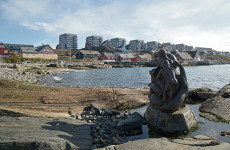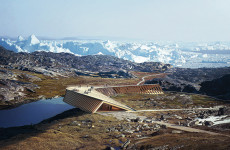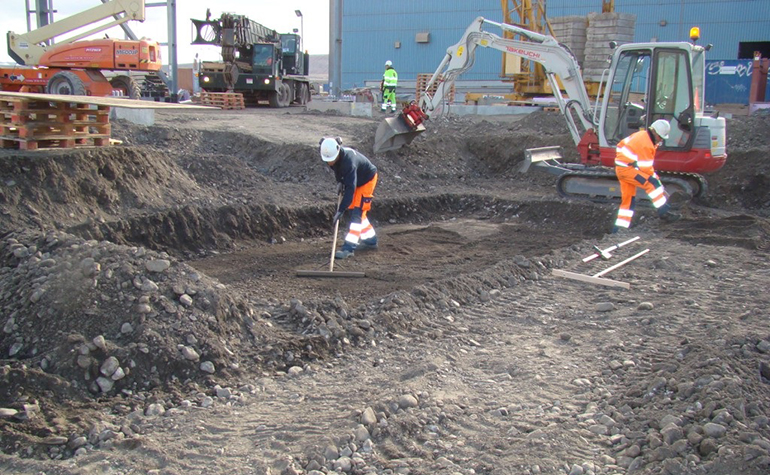
Recent missile threats to the United States has the U.S. Military looking up to its northern most installation in Thule Air Base, Greenland. It’s there that the U.S. Air Force monitors the skies for missiles from its Arctic location strategically positioned at the halfway point between Washington, D.C. and Moscow.
By JoAnne Castagna, Ed.D.
»Thule’s unique location makes it a key asset to the United States, however its unique environment makes it a difficult asset to maintain,« said Dan Rodriguez, acting-Deputy Base Civil Engineer, Peterson Air Force Base.
 Bldg. 101, a new modern 48 person dormitory for housing unaccompanied enlisted personnel stationed at Thule. Credit: USACE.
Bldg. 101, a new modern 48 person dormitory for housing unaccompanied enlisted personnel stationed at Thule. Credit: USACE.
Consolidation of Thule Air Base
The U.S. Army Corps of Engineers, New York District is doing something to address both of these areas. They are performing a major base consolidation that will save energy, tax-payer money and most importantly improve U.S. Air Force readiness.
Thule pronounced »Two Lee« is Latin for northernmost part of the inhabitable world. Thule Air Base is located in the northwestern corner of Greenland, in a coastal valley 700 miles north of the Arctic Circle and 950 miles south of the North Pole.
For over half a century, the base has been home to active-duty Air Force members who live and work in this remote and harsh environment to perform National security.
Throughout this time, the Army Corps under extreme arctic weather conditions, has helped the base fulfill this mission by constructing many structures including several dormitories, an aircraft runway, taxiways and aprons and even a medical facility. Now the Army Corps is consolidating and modernizing the base.
 Men working on the construction of the Thule Consolidation.
Men working on the construction of the Thule Consolidation.
Thule Air Base’s history
In the early 1950’s, the base’s main mission was to be an aircraft refueling stop. It was home to 10,000 U.S. military airmen and there were many buildings spread throughout the entire base.
During the Cold War Era, the base’s mission changed and it is now performing missile warning and space surveillance for the United States.
Today, the base is home to 650 personnel – 200 are U.S. Military and the rest are Danish and Greenlandic residents.
Many of the original buildings are still in use, but have become severely weatherworn, energy and fuel is being wasted to heat them and they are a distance to travel to.
These buildings are also a distance from the base’s central heat plant. This requires maintaining long pipes to transport heat to these old buildings.
 Bldg. 102, a new modern 54 person dormitory for housing enlisted personnel. Credit: USACE.
Bldg. 102, a new modern 54 person dormitory for housing enlisted personnel. Credit: USACE.
Energy savings
The U.S. Air Force, as the rest of the U.S. Military, has been on a mission to save energy. Because of this, they decided to call on the Army Corps to consolidate the base.
»Much energy and money will be saved by not heating those archaic facilities,« said Stella Marco, project manager, New York District, U.S. Army Corps of Engineers.
The consolidation effort will reduce the size of the base by 40 percent.
The Army Corps is doing this by demolishing 31 old buildings and building new structures closer together in the central area of the base where essential services are located including the airfield and hangars, dining facility and hospital.
The main structures that are being constructed are dormitories for non-commissioned officers who are visiting or on temporary duty at Thule.
Presently, the Army Corps is working on five dormitory projects. This includes constructing flattop and high rise dormitories and renovating 636 existing dorm rooms.
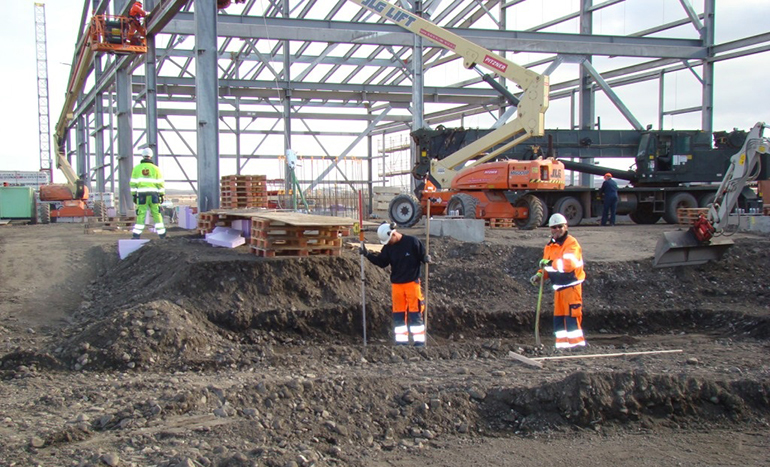
Building the future in the Arctic
The Army Corps is also constructing a base supply and civil engineering shop and a vehicle maintenance and pavements and grounds facility. Other possible projects include expanding the base’s air passenger terminal and air freight terminal.
These new and renovated buildings are going to be heated with an upgraded heating system. The base’s heating plant is receiving new more energy efficient exhaust gas heat recovery boilers and engines.
The new system will recover waste heat from the engines for production of steam to the steam distribution system that is being converted to a hot water system.
Performing construction in an Arctic environment is challenging and the Army Corps is an expert on this after having performed work for the base for over half a century.
Consolidation is always good as a way to save energy and money, but it is even more important in the Arctic. »At such a remote and cold location, construction, maintenance and utility costs are very high,« said Markus Tyboroski, Site Support Engineer, Thule Air Base.
»For example, it costs three times as much to build a new facility at Thule as compared to an average location in the United States and annual fuel costs for power and heating are $12 million.«
 Bldg. 103. The first 72 room dormitory built to modern standards for Junior & Senior Non-Commissioned Officer’s. Credit: USACE.
Bldg. 103. The first 72 room dormitory built to modern standards for Junior & Senior Non-Commissioned Officer’s. Credit: USACE.
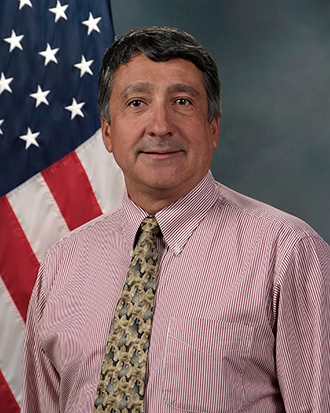 Reduced operation with many benefits
Reduced operation with many benefits
»This consolidation, will result in reduced base operation and maintenance costs and will provide energy savings,« said Rodriguez. »It’s estimated that there will be an energy reduction of 35 percent. Since 2009, when the consolidation was starting up, the base has saved almost $37 million in energy savings and in base operating costs.«
Ultimately, the consolidation effort is to benefit the Airmen protecting our Nation. Rodriguez said, »The consolidation will provide Airmen improved support because they are receiving modernized facilities and the buildings will be closer together. It’s great to see the project funded and in the works.«
Dan Rodriguez, acting-Deputy Base Civil Engineer,
Peterson Air Force Base.
About the Author
Dr. JoAnne Castagna is a Public Affairs Specialist and Writer for the U.S. Army Corps of Engineers, New York District. She can be contacted at joanne.castagna@usace.army.mil
 M-Plant, Thule’s main power plant that houses the latest energy efficient exhaust gas boilers. Credit: USACE.
M-Plant, Thule’s main power plant that houses the latest energy efficient exhaust gas boilers. Credit: USACE.
Construction challenges in the Arctic
-
Construction in the Arctic can be challenging due to severe weather and limited daylight, which requires the use of unique building materials, techniques and fast paced construction.
-
Most of northern Greenland is covered with permafrost, which is permanently frozen ground – ranging from 6 to 1,600 feet in depth.
-
This requires structures to be constructed with a special elevated Arctic foundation. If buildings are not constructed off of the ground, the heat from inside the building can melt the permafrost, making the ground unstable and causing buildings to sink.
-
Buildings are elevated three feet from the ground with the use of spread footings that go down about 10 feet deep and concrete columns that come up and support the floor system above the ground.
-
Construction takes place during the summer and autumn months when the temperature is a »balmy« 40 degrees Fahrenheit. In the winter, temperatures can be as low as minus 30 degrees Fahrenheit.
-
It is also during this time of year that there is sufficient daylight. Because of Thule’s proximity to the North Pole, the region has 24-hours of sunlight from May thru August and 24-hours of darkness from November thru February.
-
The warmer weather makes it possible to break up the iced in shipping lanes. This allows cargo ships into port that are supplied with fuel and building materials.
-
Building materials include prefabricated parts so that the workers can perform construction rapidly. Materials include concrete foundations, insulated steel and metal walls and roof panels.
-
When winter arrives, workers begin interior construction. This work includes constructing mechanical, electrical, plumbing and fire protection systems that are designed to withstand extreme frigid sub-zero temperatures.
 Bldg. 101 in construction, note the raised footing for proper ventilation to maintain the permafrost conditions, steel frame to be enclosed with a pitched metal roof & insulated exterior panels. Credit: USACE.
Bldg. 101 in construction, note the raised footing for proper ventilation to maintain the permafrost conditions, steel frame to be enclosed with a pitched metal roof & insulated exterior panels. Credit: USACE.


